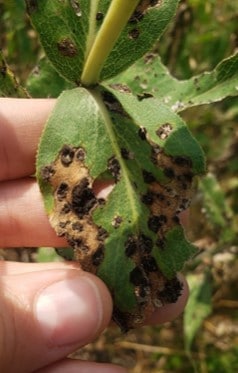Punctuating the dust and dryness in my research plots is the sound of brown leaves scraping together – a sound typically heard in October when leaves begin to die on purpose as plants prepare for the winter. In July, however, the scrape of brown leaf on brown leaf is not good and the noise has nothing to do with the dry heat. Plants making this noise are infected – much like you would assume a person with a rattly cough is not well. Infections from pathogens – like rust – aptly named due to the amber, brown color of their reproductive pustules – push themselves into plant cells and leech on plant nutrients until the tissue dies. Sometimes the whole leaf or even the whole plant dies. Surprisingly, the brown noisy leaves are a result of a defense mechanism – cellular death surrounding an infected cell to prevent spread. That being said, the sounds still draw my attention like a doctor to a cough.
 A picture of rust and of cellular death – the plants response to rust.
A picture of rust and of cellular death – the plants response to rust.
Plant defense is so foreign to humans that we hardly think of leaves and flowers as combat-zones; however, like your skin and immune system, plants have cuticles and cell walls to keep the enemy out and biochemical defenses to kill any that break through the first line of defense. Each plant’s immune system is as different as mine is from yours and this is the basis of my research. I inspect hundreds of plants each day I am in the field and record other metrics about their condition. I search for stem borers, nestled in the sponge-like interior of the stalks, leaf boring or chewing insects, flower gorging caterpillars and like rust, other pathogens that leave tell-tale signs of their invasion. The plants are almost always fighting back or are so well defended that I cannot detect signs of damage on plants where known enemies are present. I study the differences in plants ability to response to their invaders and how this is useful for us. By taking time each summer to walk, visualize and yes, sometimes listen to the sounds of combat – I learned a lot about what a well defended Silflower plant can do.
Silflower or Silphium integrifolium, is being developed as a perennial oilseed that grows and looks and could have similar uses to sunflower. Its seeds can be harvested and pressed for oil – which you would use or eat much like you would use avocado oil, canola oil or vegetable oil. If you are lucky enough to have cows, Silflower is an excellent forage, however it has pests and pathogen problems like all modern crops. It’s hard to develop a crop that is constantly being eaten in random places throughout your fields. Selection in this environment is not productive. It would be like evaluating your employees when some are being stung by bees all day and others are not – who’s productivity is greater? Those who are still productive despite being bothered all day, or those, in places where there are no bees, are producing more? What if those being stung by bees are more productive than those without the bother, but you just cannot evaluate them properly? You are now in every plant breeders’ shoes who does not have an even distribution of pest or pathogen presence in their plot. Stalled.
 Silflower offers many ecosystem benefits, including acting as a pollinator resource.
Silflower offers many ecosystem benefits, including acting as a pollinator resource.
Thanks to funding from the Foundation for Food & Agriculture Research (FFAR) and my industry partner, the nonprofit research organization The Land institute, I have studied 600 plants over 3 years across 500 miles of the Midwest to collect large datasets to look at these traits. Working with The University of Kansas, Illinois State University and my department at the University of Minnesota, we have investigated thousands of plants and found differences in their abilities to defend themselves against enemies. My Ph.D. research, built on a strong academia-industry partnership, has relied on skills I have developed as a FFAR Fellow: project management, communication, team-building and other skills learned from invaluable webinars with industry leaders.
 Two plants, inches apart, one is clearly eaten by insects and another is not.
Two plants, inches apart, one is clearly eaten by insects and another is not.
 Kelsey in a field of perennial crops.
Kelsey in a field of perennial crops.